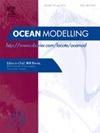大陆尺度的总水位预测:沿岸海洋
IF 3.1
3区 地球科学
Q2 METEOROLOGY & ATMOSPHERIC SCIENCES
引用次数: 0
摘要
我们以美国东海岸/墨西哥湾沿岸海洋为例,展示了大陆尺度总水位(TWL)模拟的最新进展。大陆尺度建模与小尺度建模的主要区别在于前者需要更精确的垂直基准。利用基于大地水准面的基准(xGEOID20b)、卫星测高产品和最先进的三维非结构网格模型,我们显著提高了近海和近海 TWL 的精度。NOAA 所有站点的平均均方根误差为 14 厘米。我们发现,非潮汐信号对边界附近大尺度海流系统的表示非常敏感,而扩大域范围以适应该系统则可改善这些信号。本文章由计算机程序翻译,如有差异,请以英文原文为准。
Total water level prediction at continental scale: Coastal ocean
We demonstrate recent progress made in the simulation of total water level (TWL) at continental scale, using the coastal ocean of US East Coast/Gulf of Mexico coast as an example. A key difference between the continental-scale and small-scale modeling is that the former requires a more accurate vertical datum. Using a geoid-based datum (xGEOID20b), a satellite altimetry product, and a state-of-the-art 3D unstructured-grid model, we significantly improve the accuracy for TWL both near- and off-shore. The average root-mean-square error at all NOAA stations is 14 cm. The non-tidal signals are found to be sensitive to the representation of a large-scale current system near the boundary and extending the domain extent to accommodate this system improves these signals.
求助全文
通过发布文献求助,成功后即可免费获取论文全文。
去求助
来源期刊

Ocean Modelling
地学-海洋学
CiteScore
5.50
自引率
9.40%
发文量
86
审稿时长
19.6 weeks
期刊介绍:
The main objective of Ocean Modelling is to provide rapid communication between those interested in ocean modelling, whether through direct observation, or through analytical, numerical or laboratory models, and including interactions between physical and biogeochemical or biological phenomena. Because of the intimate links between ocean and atmosphere, involvement of scientists interested in influences of either medium on the other is welcome. The journal has a wide scope and includes ocean-atmosphere interaction in various forms as well as pure ocean results. In addition to primary peer-reviewed papers, the journal provides review papers, preliminary communications, and discussions.
 求助内容:
求助内容: 应助结果提醒方式:
应助结果提醒方式:


